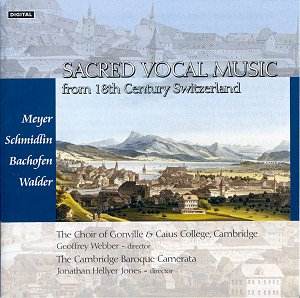In reviewing ‘Voices
of Africa’ for this site, I suggested that Guild, which already
enjoys an enviable reputation amongst specialist collectors of cathedral
choral music, was spreading its net ever wider to encompass a varied
and eclectic repertoire. This is furthered on this very enjoyable and
stimulating disc financed with the help of the ‘Zentralbibliothek Zurich;
Switzerland being also Guild’s home base. The disc and its companion
(GMCD
7255) adds to a previous duo of Swiss music issued by Guild (GMCD
7175 and GMCD 7177).
Sacred Vocal Music, has works set to both Latin
text and German words. The Latin setting by Schmidlin, ‘Gloria’ (tr
2) and ‘Magnificat’ (tr 9) are, to my ears, much leaner in musical invention
than, for example, Bachofen’s ‘Trio’ (tr 6), and particularly ‘Aria
à due’ (tr 8) that I found particularly enjoyable. In the latter
piece Jennifer Dunford and Catherine Bell match each other, phrase by
phrase, with pure tone and legato line including delightful ‘sotto
voce’ singing - nearly eight minutes of vocal and musical delight!
Indeed it is the vocal strength of the four soloists in Schmidlin’s
long ‘Magnificat’ (tr 9) that distracts from the lack of musical invention
in the piece. Enjoyable too is Bachofen’s other ‘Arie à due’
included here (tr 3) albeit the melodic invention is leaner than on
track 8 and the voices are soprano and bass. The soprano, Abigail Boreham
sings with eloquence although I would have enjoyed a more graceful ending
to some phrases, whilst the bass (more baritone in timbre) has clear
abbreviated staccato passages early in the piece his tone is rather
dry later on.
The ‘Hymno Ambrosiano’ by Meyer (tr 1) betrays a warm,
vibrant, Latin influence probably related to the composers training
in Milan and being Lucerne-based rather than Zurich. The two sopranos
sing here with admirably pure tone. The sleeve-note suggests that it
is music that owes much to the contemporary South German Catholic tradition.
The choir singing here, and indeed throughout, is of a high standard
with excellent balance and articulation.
The recording catches the voices, soloists and choir
in a clear and warm, but not over-resonant acoustic, whilst the contributions
of the Cambridge Camerata and the organ continuo are supportive not
intrusive. The sleeve-note by John Reed Coulter of the University of
Pretoria could gainfully have been somewhat more informative and discursive.
All texts are given with English translation.
The supporters of Guild’s eclectic repertoire will
find much to enjoy in this disc.
Robert J Farr
